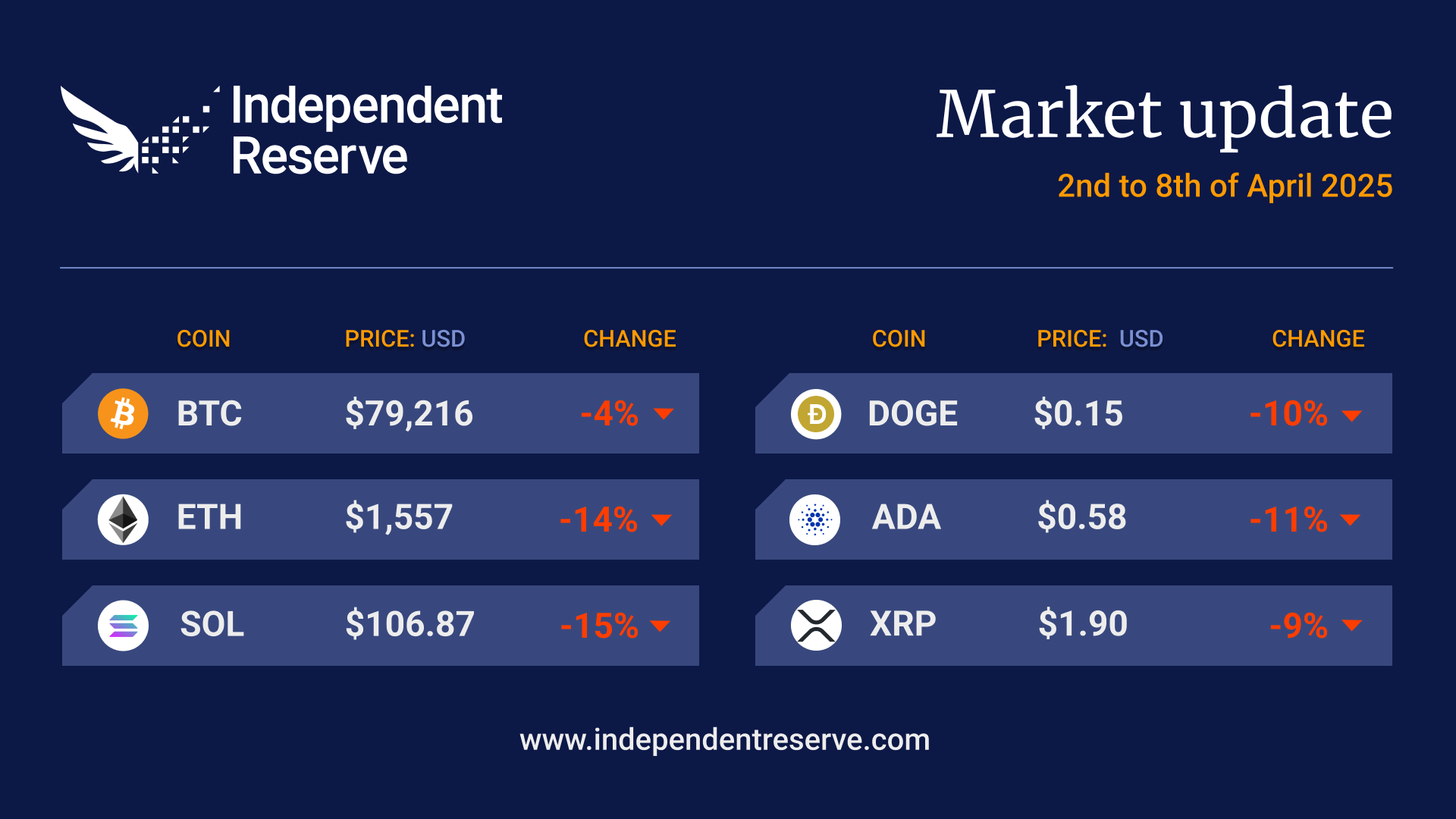In Markets
While crypto markets remain approximately A$1.6 trillion (US$1T) down from December’s peak, things are certainly looking more positive than last week — Donald Trump’s erratic trade war remains the prime mover. Markets saw big gains after he suspended tariffs above 10% on everyone but China for 90 days and later exempted big tech products from China, too (though how long for remains up in the air). Trump was left with no choice after investors began dumping US bonds — one of the clearest warning signs of an approaching full-blown financial crisis. The Wall Street Journal says there are now worrying signs investors are starting to lose faith in American economic management. Many analysts anticipate a range-bound pattern for Bitcoin until the tariff picture becomes clearer. “BTC continues to consolidate within the US$80K-$90K (A$126K to $142K) range and could continue trading sideways, adopting a ‘wait and see’ approach to the tariff situation,’ said QCP Capital on Telegram. Bitcoin has held up incredibly well throughout the crisis and finishes the week up 6% to trade around A$133,784 (US$84,891), while Ethereum is up 3% to trade aroundA$2,565 (US$1,612). XRP gained 14%, Solana surged 20%, Dogecoin was up 8%, and Cardano gained 9%. The Crypto Fear and Greed Index is at 31, or Fear.

From the OTC Desk
Market overview
- Market bounce: The market found a much-needed respite after President Trump announced a three-month pause on all tariffs, except those targeting China. This unexpected reversal sparked optimism in the macro environment, further supported by lower-than-expected U.S. inflation figures. The U.S. Inflation Rate YoY was reported at 2.4%, below the consensus forecast of 2.6%. This result keeps the possibility open for a more dovish Federal Reserve at its next meeting in early May.
- Semiconductor tariffs: Over the weekend, the Trump administration chose to exempt certain electronic devices, such as smartphones and computers, from the 145% levy planned for Chinese imports. As of today, 145% remains the current levy rate as both nations persist with retaliatory measures. On Monday, however, the President clarified that smartphones would be placed under a separate “semiconductor tariff” category, with further details to be announced later.
- Macro picture: The S&P 500 Index rose from a yearly low of 4,835 on Tuesday to close at 5,406. Similarly, the Nasdaq Composite climbed from 14,784 to close at 16,831 over the week. BTC/USD moved from US$76,500 to US$85,000 last night.
- Mantra shock: Early Monday morning, crypto traders were jolted by a market upheaval as the price of OM — the native token of the Mantra Blockchain — plummeted by over 90%, wiping out more than US$5B in market capitalisation. Mantra’s co-founder posted on X, stating that the team was working to resolve the issue and attributing the crash to “reckless forced closures initiated by centralised exchanges,” exacerbated by low liquidity. Others pointed to different causes, including significant insider holdings, delayed airdrop distributions creating a fragile ecosystem, and rumoured discounted token sales via OTC.
OTC desk activity
- Lower volumes amid tariff uncertainty, but growing interest in purchasing coins during this dip.
- Two-way stablecoin flow, with increased buying activity later in the week.
Key economic calendar events (AEST)
• Wednesday, 16 April, 12 pm: China GDP Growth Rate, Industrial Production, Retail Sales
• Thursday, 17 April, 10:15 pm: ECB Interest Rate Decision (Consensus 2.4%)
• Thursday, 17 April, 10:45 pm: ECB Press Conference
For any further information, please feel free to reach out.
In Headlines
Good news for Ripple #1
Ripple has bought the Hidden Road prime broker for US$1.25 billion (A$2.13B) in one of the largest deals seen in the crypto space. Prime brokers are trusted intermediaries for big hedge funds, OTC desks, quant traders and market makers. Hidden Road clears around US$3 trillion (A$4.74T) annually, and Ripple intends to add some of that volume to its blockchain. “Instead of waiting for <24 hours to settle trades through fiat rails, Hidden Road will be using XRPL for clearing a portion of trades, and most consequentially, using RLUSD as collateral across its prime brokerage services, including cross-asset (crypto and traditional instrument) trades,” said CEO Brad Garlinghouse.
Good news for Ripple #2
In the short term, tariffs are bad for crypto markets – but could they end up propelling prices? Some hopefuls suggest so, with newly pardoned BitMEX co-founder Arthur Hayes saying: “Global imbalances will be corrected, and the pain papered over with printed money, which is good for BTC.” He’s tipping an “ascent to $250,000 (A$417K) by year-end.” One theory popular on social media, and reposted by Trump himself, is that the President is crashing the market on purpose to lower the interest rate bill when the US refinances US$9.2T (A$15.3T) of debt this year. However, White House National Economic Council director Kevin Hassett denied this on Sunday night, saying, “It is not a strategy for the markets to crash.” China has actually been selling US bonds, which is pushing rates higher rather than lower, but Bitwise analyst Jeff Park believes a lower dollar and lower yields are both possible and good for Bitcoin. Zach Pandl, head of research at Grayscale, said: “I think tariffs will weaken the dominant role of the dollar and create space for competitors including bitcoin.”
Ether ETF staking delayed
The SEC has kicked the can down the road on Grayscale’s application to add staking yield to its Ether ETFs. The decision has now been delayed until June 1, along with a decision on allowing in-kind creation and redemptions for the Van Eck crypto ETFs, which has been postponed until June 3. While the SEC has reversed a range of anti-crypto measures so far, the regulator’s crypto task force wants more time to assess how the proposed rule changes fit with its broader digital asset regulation strategy under development. Meanwhile, the first Solana ETF with staking is expected to go live in Canada this week.
Ethereum upgrades locked in
Ethereum’s next major upgrade, the Pectra hard fork, is now scheduled for May 7, with client software expected by the end of this week. Developers are already shifting focus to 2025’s second Ethereum fork called Fusaka, which is planned for later this year. Fusaka will introduce PeerDAS, a significant step forward in improving data availability for Layer 2 networks. The next major upgrade after Fusaka – codenamed Glamsterdam – aims to increase Ethereum’s gas limit by 9x to boost transaction throughput. With so much bearishness around Ethereum scaling, there’s a lot of support now for accelerating the pace of hard forks to right the ship.
Crypto ETFs flounder amid uncertainty
BlackRock’s crypto ETFs saw US$3 billion (A$4.74B) in net inflows in the first quarter of 2025 — a decent enough showing but 83% down from the strong fourth quarter of 2024. Overall, the spot Bitcoin ETFs lost more than US$700M (A$1.1B) in outflows last week. Meanwhile, the Ether ETFs have seen seven straight weeks of net outflows, with US$82.47 million (A$130M) withdrawn in the past week. And in more bad news for Ethereum, the most successful ETF strategy so far in 2025 has been shorting Ethereum. ProShares UltraShort Ether ETF (ETHD) and T Rex 2X Inverse Ether Daily Target ETF (ETQ) are up by 247% and 219% respectively, according to Bloomberg Intelligence.
Latest crypto implosion
Real-world asset tokenisation L1 blockchain Mantra entered a world of pain this week, with its OM token losing more than US$5 billion (A$7.9B) in a sudden plunge that looked very much like a rug pull. Cofounder JP Mullin attributed the crash to “reckless forced liquidations” by centralised exchanges in thinly traded hours and denied any involvement by the team. Ahead of the crash, 17 wallets transferred about 4.5% of the circulating supply to exchanges.
US crypto legislation by August?
Chairman of the US Senate Committee on Banking, Senator Tim Scott says he expects a crypto market bill will be passed into law by August. He said the committee’s advancement of the GENIUS stablecoin bill last month was evidence that it is prioritising crypto law reform. “We must innovate before we regulate — allowing innovation in the digital asset space to happen here at home is critical to American economic dominance across the globe,” he told FOX. Kristin Smith, CEO of the Blockchain Association, also expects the crypto market structure bill to pass by August.
Until next week, happy trading!


